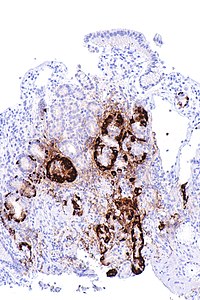
Photo from wikipedia
INTRODUCTION Molidustat is an oral hypoxia-inducible factor prolyl hydroxylase inhibitor that predominantly induces renal production of erythropoietin (EPO). Molidustat was evaluated for the treatment of anemia associated with chronic kidney… Click to show full abstract
INTRODUCTION Molidustat is an oral hypoxia-inducible factor prolyl hydroxylase inhibitor that predominantly induces renal production of erythropoietin (EPO). Molidustat was evaluated for the treatment of anemia associated with chronic kidney disease (CKD) in the "Molidustat Once Daily Improves Renal Anemia by Inducing EPO" (MIYABI) program, which comprises 5 phase 3 clinical trials. The present MIYABI Non-Dialysis Correction (ND-C) study investigated the efficacy and safety of molidustat in Japanese patients with renal anemia who were not undergoing dialysis and were not receiving erythropoiesis-stimulating agent (ESA) treatment. METHODS This was a 52-week, randomized (1:1), open-label, active-control, parallel-group, multicenter, phase 3 study in Japanese patients with renal anemia associated with CKD (stages 3-5). Molidustat or the ESA darbepoetin alfa (hereinafter referred to as darbepoetin) were initiated at 25 mg once daily or 30 μg every 2 weeks, respectively, and doses were regularly titrated to correct and to maintain hemoglobin (Hb) levels in the target range of ≥11.0 g/dL and <13.0 g/dL. The primary efficacy outcome was the mean Hb level and its change from baseline during the evaluation period (weeks 30-36). The safety outcomes included evaluation of all adverse events. RESULTS In total, 162 patients were randomized to receive molidustat (n = 82) or darbepoetin (n = 80). Baseline characteristics were generally well balanced between treatment groups. The mean (standard deviation) Hb levels at baseline were 9.84 (0.64) g/dL for molidustat and 10.00 (0.61) g/dL for darbepoetin. The mean (95% confidence interval [CI]) for mean Hb levels during the evaluation period for molidustat (11.28 [11.07, 11.50] g/dL) and darbepoetin (11.70 [11.50, 11.90] g/dL) was within the target range. Based on a noninferiority margin of 1.0 g/dL, molidustat was noninferior to darbepoetin in the change in mean Hb level during the evaluation period from baseline; the least-squares mean (95% CI) difference (molidustat-darbepoetin) was -0.38 (-0.67, -0.08) g/dL. The proportion of patients who reported at least 1 treatment-emergent adverse event (TEAE) was 93.9% for molidustat and 93.7% for darbepoetin. Most TEAEs were mild (54.9% for molidustat and 63.3% for darbepoetin) or moderate (22.0% for molidustat and 22.8% for darbepoetin) in intensity. There were 3 deaths in the molidustat group and 1 in the darbepoetin group. DISCUSSION/CONCLUSION In the MIYABI ND-C study, molidustat appeared to be an efficacious and generally well-tolerated alternative to darbepoetin for the treatment of renal anemia in Japanese patients who were not undergoing dialysis and were not receiving ESA treatment.
Journal Title: American journal of nephrology
Year Published: 2021
Link to full text (if available)
Share on Social Media: Sign Up to like & get
recommendations!